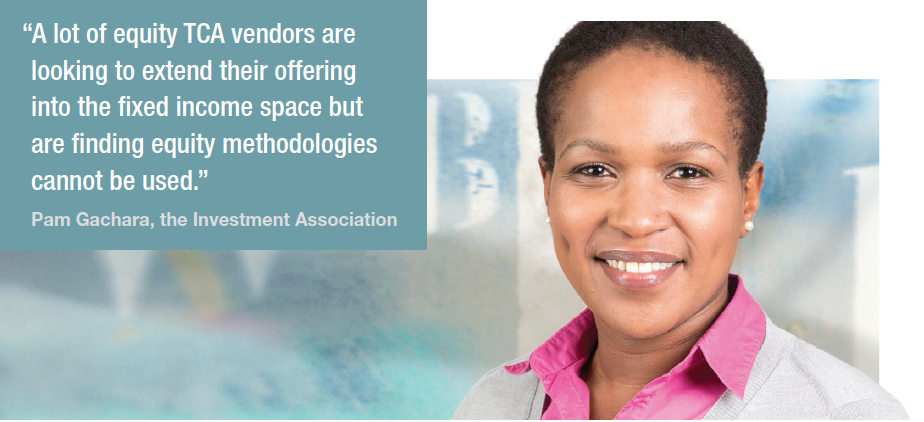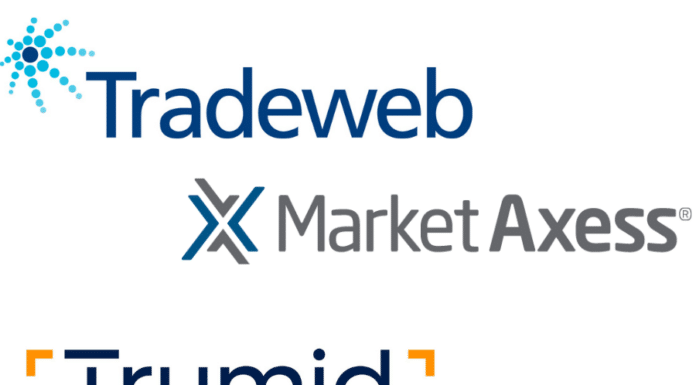Transaction cost analysis is becoming more sophisticated despite data limitations. Lynn Strongin Dodds looks at the current offerings.
Fixed income markets are becoming more transparent. That provides one part of the solution to transaction cost analysis (TCA) for bond trading. Yet fixed income TCA is still at a nascent stage. Offerings remain incomplete, in part because post-trade analysis has progressed further along the development curve than pre-trade.
It will take time for vendors to provide a complete picture, according to Anna Pajor, director & principal consultant at GreySpark Partners. “If you look at the tools on the market, they are taking into account many different situations but the current structure is not ideal because there are not that many data sets available. It will improve in time and the analysis will become more sophisticated as more data points become available.”
Regulatory pressure is driving up the level of post-trade reporting in bond trading. In Europe MiFID II will make considerable demands of trading firms. In the US the Securities and Exchanges Commission have asked the Financial Industry Regulatory Authority (FINRA) to capture post trade data in the US treasuries market. As the level of sell-side risk participation decreases across instruments, conditions are pushing more bonds on to electronic platforms. That makes it easier and faster to capture trade execution data.
On the other hand, huge swathes of the market barely trade, making it difficult to unearth accurate pricing information. A recent study by TABB Group, ‘Work in Progress’, reveals that roughly 13% of its 15,444 sample of US bonds across both high yield and investment grade markets during January 2016, traded once while around 20% changed hands two to three times. Using the same sample, just over 12% of bonds traded every day during the 19-day period.
“There’s clear increasing demand from trading desks and compliance for valid fixed income TCA solutions; drivers include regulation and investors seeking more transparency,” says Enrico Bruni, head of Europe and Asia business at Tradeweb. “However, the equity style methodology is not fit for the FI and OTC market, they are traded very differently.”
 Pam Gachara, manager for markets at buy-side trade body, the Investment Association, concurs, “A lot of equity TCA vendors are looking to extend their offering into the fixed income space but are finding equity methodologies cannot be used. Not only because equities and bonds trade very differently, but there are data issues that make benchmarking a challenge. For example, look at the corporate bond universe, if a bond has not traded in the last eight months what do you benchmark it against? The last price is not the best reflection in changing market conditions.”
Pam Gachara, manager for markets at buy-side trade body, the Investment Association, concurs, “A lot of equity TCA vendors are looking to extend their offering into the fixed income space but are finding equity methodologies cannot be used. Not only because equities and bonds trade very differently, but there are data issues that make benchmarking a challenge. For example, look at the corporate bond universe, if a bond has not traded in the last eight months what do you benchmark it against? The last price is not the best reflection in changing market conditions.”
The travails of creating a useable benchmark are also highlighted in the TABB report. Co-authors – global head of research and consulting, Anthony Perrotta, and analyst Colby Jenkins believe that one of the biggest hurdles for solution providers is to make clients comfortable with the approach they are taking in establishing a benchmark baseline for bond pricing. This challenge will be compounded when solutions need to be applicable across the board for different securities, depending on the clients’ trading profile.
Golden opportunity
The need for fixed income TCA presents a golden opportunity and there is no shortage of firms trying to develop solutions. The TABB report singles out three – ICE Data Services (formerly Interactive Data Corporation), Markit, and Bloomberg – as being ahead of the curve.
The reason why ICE Data Services Continuous Evaluated Pricing (CEP) product was singled out is due to its ability to spew out highly contextualised best execution reports tailored to an investor’s profile. Analysis can be broken down based on specific trades with certain counterparties, on certain venues, and with specific trading protocols Performance can then be mapped out in relation to the marketplace, according to the report.
The objective of CEP is to extend the reach of fixed income end-of-day evaluations into intraday applications for things like pre-trade transparency, price discovery, enhanced trading workflow and best execution analysis. It covers EMEA corporates and sovereigns, EMEA money markets, US corporate bonds, US treasuries, US agency debentures and mortgage backed securities.
“We have a relatively simple approach but we capture the nuances of the market,” says Bill Gartland, senior director of evaluation services at ICE Data Services, says, “It gives our clients perspective and a greater understanding of performance and the outliers of the market.”
Markit’s fixed income TCA product which has been running since early 2015 and similarly to ICE Data Services, it leverages the firm’s existing pricing service. It is aiming to offer detailed insights into around 2.5 million US and European securities either hourly or daily. Reports break down aggregate fixed income trades across asset classes in terms of benchmark summaries, volume, costs and dealer cover.
 According to Colby, the range of market-level statistics available within these reports is set to grow significantly by the end of the year and the product will evolve from principally an end-of-day cost summary tool to one with intra-day statistics and contextual analysis to clients’ flow.
According to Colby, the range of market-level statistics available within these reports is set to grow significantly by the end of the year and the product will evolve from principally an end-of-day cost summary tool to one with intra-day statistics and contextual analysis to clients’ flow.
As for Bloomberg Transaction Cost Analysis (BTCA), it is available to clients with a Bloomberg terminal with transactional data being captured directly from the firm’s platforms as well as external sources of trade data. It uses its internal central contributed data and evaluated pricings engine to calculate performance benchmarks such as their Composite Bloomberg Bond Trader (CBBT), Bloomberg Benchmark (BMRK). BVAL, Bloomberg’s evaluated pricing source.
Charles River has also won industry plaudits for its integrated order and execution management systems that centralises connectivity to dealers and trading systems on a single desktop and provides support with trade decisions. Different data sources are incorporated in the OEMS, based on an instrument’s trade characteristics, sector and liquidity profile, according to Michael Beattie, director of product management at Charles River Development. There are also appropriate reference prices and calculation options which are applied that can offer a context for each trade’s execution quality.
 “The advantage of the OEMS is that the breadth of data is consolidated and normalised in one place so that traders have the information at their fingertips and they can now efficiently make comparisons across counterparties, regions, or asset classes,” says Beattie. “This is important in fixed income because there is no consolidated tape. Over the long term, I can see the data being used to drive the decision making process pre-trade.”
“The advantage of the OEMS is that the breadth of data is consolidated and normalised in one place so that traders have the information at their fingertips and they can now efficiently make comparisons across counterparties, regions, or asset classes,” says Beattie. “This is important in fixed income because there is no consolidated tape. Over the long term, I can see the data being used to drive the decision making process pre-trade.”
Although there are variations on a theme there are also common threads. In the TABB report, Colby notes that the vendors identified are “moving past being used as simply a cost slippage tool, to provide insight into execution quality whether it is in terms of venue or broker coverage or even execution method. They can take aggregate views of their activity and isolate any outlying trades above a threshold that might correlate to any of these metrics,” he adds.
Colby warns though that this is just the tip of the iceberg and that the tools are at the embryonic stage. TCA and compliance policies remain a moving target from firm to firm and their success will be their ability to integrate them into existing workflows and combine them with internal expertise.
Tom Kennedy, proposition manager, enterprise capabilities at Thomson Reuters also believes analytics will be a key differentiator in the future. “TCA across non-equity asset classes is still in its infancy and this is partly due to the lack of post-trade data and illiquidity in certain instruments. Regulation such as MiFID will tackle these issues, making it possible for new innovative tools and analytics to make better execution decisions. I think in time we will see TCA moving from a static process to a dynamic and interactive service that provides real-time insights into trading activity.”
Colby also believes that going forward fixed income TCA solutions will become more prevalent in pre trade decisions much in the same way TCA in equities has evolved.
©The DESK 2016
©Markets Media Europe 2025










